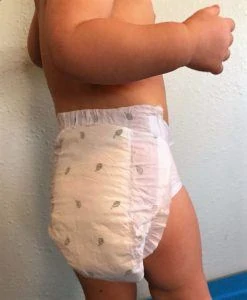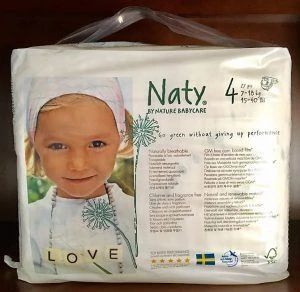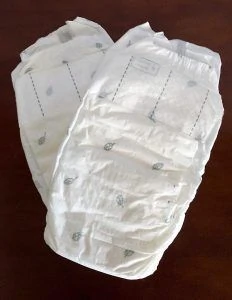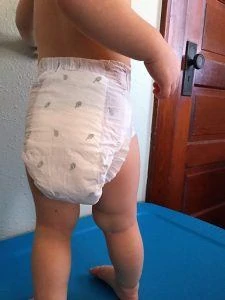Do you long for the benefits of cloth diapers with the convenience of disposable diapers? Are you looking for diapers that are both good for your baby and kind to the environment?
With Naty diapers, you can still use disposable diapers while minimizing your carbon footprint and reducing your baby’s exposure to toxins.
We’ve tried these economical diapers and have listened to hundreds of Naty users’ opinions, and we’re here to share all we’ve learned. We’ll compare them to other leading natural diaper brands and share the pros and cons of Naty diapers.
Read on for our Naty diaper review to find out if they are the perfect solution for your eco-friendly diapering desires.
What You Should Know Before Buying Natural Diapers
If you’ve ever shopped for diapers, you know there’s no shortage of options. And now, many brands are using natural materials instead of chemicals for absorbency.
With so many options available, it can be overwhelming, and you may need to try several brands before finding out what works for your baby and your family.
If you decide to go the natural route, there are several things you should look for in a diaper:
- Fewer chemicals: The fewer synthetics used, the more natural a diaper will be. Look for diapers that are free of fragrances, dyes, GMOs, chlorine, latex, phthalates, and other allergens and irritants.
- Eco-friendliness: True eco-friendly diapers will be made with biodegradable materials and have recyclable packaging.
- Cost: Green diapers are usually more expensive than conventional diapers, with most brands costing approximately $0.10 more per diaper than non-natural options. However, you can often reduce your diaper cost by purchasing in bulk. And don’t forget to consider the cost to our environment when you use chemical-laden diapers.
- Softness: You want to make sure your baby is comfy, so you’ll need a diaper that is ultra-soft, smooth, and perfect against your baby’s skin.
- Absorbency: If you’re tired of dealing with leaks, then you’ll probably just want the most absorbent option out there. Some diapers use more absorbent materials than others, so it’s worth trying a sample of a few brands (especially overnight) before determining which will be best for your little one.
- Fit: Every baby is shaped differently; therefore, one diaper brand may fit your baby better than others. Find an eco-friendly diaper with a great fit around the waist and legs so you won’t have to deal with leaks and blowouts.
It may be difficult to find the entire checklist in a diaper, so you will need to decide which features are most important to you and what works best for your baby.
Product Overview
Naty disposables are eco-friendly diapers that are gentle on your baby’s skin and kind to our planet. These diapers are made with biodegradable and natural, sustainable materials and are the closest thing you’ll get to cloth diapering without all the dirty diaper laundry.
They are beautiful, comfy, and green, and you won’t have to worry about your baby being exposed to harmful chemicals while wearing them.
These are a great option if you’re planning on doing a combination of cloth and disposables or if you want to do disposables full time but still want all the health and environmental benefits of cloth. They are also a great option to keep diaper rashes at bay if your baby has super sensitive skin.
Pros
- Completely free of irritants and allergens.
- Made with natural, biodegradable materials.
- Breathable.
- Good price compared to other all-natural brands.
Cons
- No color-changing wetness indicator.
- Not available at most major retailers.
- Only average absorbency.
Key Features and Benefits
These are our favorite features of Naty diapers.
1. Eco-friendliness
You won’t feel guilty throwing another diaper in the trash with Naty disposables. Naty is devoted to eliminating as much non-biodegradable material as possible in their diapers.
They use natural, plant-based compostable materials, like compost-certified tissue and sugarcane. The leakage barrier is made with cornstarch instead of plastic, which has proven to be just as effective but completely biodegradable. All materials are 100% GMO free.
Most disposable diapers are made with plastic, dioxins, and the absorbent gel, sodium polyacrylate.
These materials don’t degrade well and will remain in our landfills for hundreds or even thousands of years. They pollute our land, water, and air with potential carcinogens and endocrine disruptors.
Naty diapers help eliminate this problem.
2. Health
Naty diapers aren’t only a healthy choice for the environment, but they are also a healthy choice for your baby.
Take Note
These diapers are 100% chlorine-free, unbleached, and fragrance-free, making them a great option for even the most sensitive skin. They are also free of other undesirable materials many mainstream diapers contain, such as phthalates, heavy metals, formaldehyde, and PVC.
My niece, who struggles with eczema, had absolutely no irritation or rashes with these diapers. It was easy to see why they are certified by the Swedish Asthma and Allergy Association.
3. Absorbency
Unlike most disposables, Naty leaves out the toxic sodium polyacrylate and sticks with wood pulp as the main absorbent. You do lose out on some absorbency because of this, but the health benefits are certainly worth it.
Overall, this diaper still has pretty average absorbency. I had to change my little one about every 2-3 hours to avoid leaks with these diapers. This wasn’t a big deal for our family, as this is how often we change our cloth diapers.
However, these diapers probably aren’t the best choice for overnight or heavy wetters. Due to their construction of biodegradable and renewable materials, the moisture will seep through if not changed frequently, and you’ll feel the wetness on the outside of the diaper.
4. Design
Naty diapers maintain a classy look with cute, simple prints, like flowers, leaves, and hearts. However, they don’t contain a wetness indicator, which is a downside for some parents who like that convenience, especially in the newborn stage.
A well-fitting diaper means fewer leaks and blowouts. The elastic gussets around the legs fit very well on my little one, and we didn’t have any leaks.
These diapers sit high on the back, but this is a good thing in helping contain blowouts when your baby is exclusively breast or formula-fed. While these diapers fit extremely well on my baby, it’s important to remember that every baby is built differently. What works for one baby may not work for another.
Unfortunately, the tabs on these diapers are pretty weak and may tear if your baby is wiggly during diaper changes or if you pull too hard. They also don’t seem to stick well if you have to readjust them. The tabs didn’t stick again when rolling up a dirty diaper.
5. Comfort
The diaper’s inner layer has a nice soft cloth feel. It seems like the closest you’ll get to real cotton against your baby’s bottom.
A cornstarch film also helps keep your baby dry, prevents diaper rash, and makes the diaper breathable, even on the hottest of days. The fit is super trim, making it easy for your baby to crawl, scoot, and climb.
However, the outside of the diaper feels rough and scratchy, almost like your baby is wearing tissue paper.
A Blessing And A Curse
How Do They Compare?
Bambo Nature vs Naty
Many moms love the Bambo Nature diaper’s comfort, fit, and wetness indicator. However, if you are looking for diapers that are truly eco-friendly, you might be surprised that Bambo Nature diapers use polyethylene (PE) and polypropylene (PP), which are plastics and oil-based materials.
Seventh Generation vs Naty
If you’re looking for a more budget-friendly green option, you may want to check out Seventh Generation Free & Clear. Many moms like that these diapers are durable, absorbent, and easy to grab at most major retailers.
However, these aren’t as kind to the environment as one would think, as they are not biodegradable, and the packaging isn’t recyclable. So if that is your primary concern, Naty is the better option.
Babyganics vs Naty
Babyganics is one of the more comfortable and durable natural diaper options.
However, many natural-minded moms wish Babyganics would offer a full disclosure list of their ingredients, as Naty does, and they are a bit leery of the diapers’ fragrant odor.
Andy Pandy vs Naty
Eco-conscious moms love that Andy Pandy diapers are made with bamboo, which is an incredibly renewable and sustainable resource. While these biodegradable diapers are an intriguing option for the environment, if you are on a limited budget or have a heavy wetter, we recommend sticking with Naty as they are less expensive and do a better job of preventing leaks.
Back to Nature with Naty
If you’re ready to ditch chemical-filled plastics and get back to nature, give Naty diapers a try. These green diapers are gentle on your baby’s skin, friendly to our planet, and kind on the wallet.










